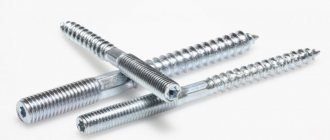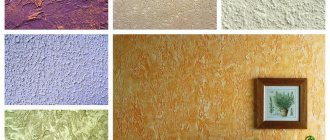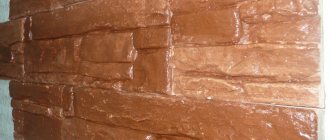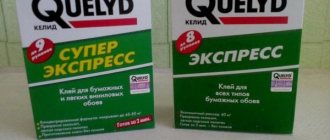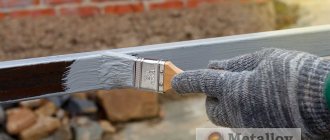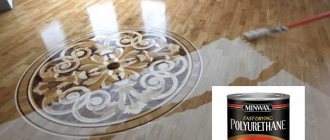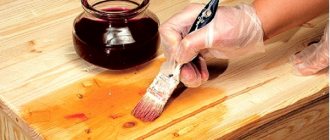Plastering walls and pouring floors in our time is often done using the “beacon” technology. This technique allows you to ultimately obtain the most even and smooth surfaces. One of the tools used when performing work using this technology is the rule.
The traditional device of this type is a regular long plank with a wooden handle. Such rules are quite convenient in work. However, they, unfortunately, do not last too long. Plasterers and painters often have to simply throw away such a tool after just one shift. Recently, a special type of rules has appeared on the market - h-shaped ones. Devices of this type are made not of wood, but of aluminum; they can last quite a long time.
A little history
Plasterers and painters in Russia began to use h-shaped rules quite recently - in the middle of the first decade of the 21st century. Today this tool is very popular among professionals. Of course, amateur finishers who independently renovated their apartments and houses also paid attention to it.
Initially, trapezoidal aluminum rules appeared on the market. Such tools have been used by craftsmen for a long time. However, the rules of this type are usually applied only for finishing the leveled surface. Actually leveling and redistributing the solution using them is not very convenient.
It is much more convenient to perform such operations with an h-shaped tool. This type of device was developed by specialists, after which the company began supplying them to the market. Plasterers and painters quickly noticed that rules with an h-shaped section are very convenient for performing the bulk of plastering work on lighthouses; such devices instantly gained popularity among professionals. Trapezoidal rules are still used today by craftsmen to perform such operations as perpendicular trimming.
H-shaped tools are currently quite popular among both professionals and amateurs. And they are, of course, being implemented in many cities across the country. If desired, you can buy an h-shaped rule in Vladimir, Moscow, Yekaterinburg and even in small towns.
Types of building regulations
Depending on the material used, the rule can be of several types. For example, the very first version of the product is considered to be wooden. In appearance, it resembles a smooth lath without additional details and a complicated appearance. Such a device can only be used to check the masonry to see how even and smooth it is. But it has one advantage - you can easily make such a design yourself, it only requires desire and a little time. Wooden structures quickly absorb moisture and dry out for a very long time and lose all their positive properties and characteristics, their appearance deteriorates (inexpensive, disposable material).
As for the metal rule, it will be needed everywhere, as it is durable. Many manufacturers produce modern and improved versions of the product - the rule is with a level.
Metal construction rule with level
It is convenient to use finished products three meters long in pairs with someone, this makes it much easier to cope with the task. This feature will speed up the work process several times. In addition, this tool can quickly and easily identify even the most hidden defects. This will allow you to achieve a positive result.
It is easy to use and is well suited for leveling any surface, as well as for checking the wall surface for vertical or horizontal differences. Building regulations are sold in different sizes. Standard types of products are from one meter in length; there are options with a length of more than two meters. The choice of the correct tool that meets all the requirements depends, first of all, on the tasks assigned to each buyer.
Design features and types
The main components of such rules are:
- leveler;
- holder.
There is a special seal on the edge of the latter, which makes using the tool more convenient and safe. The profile width of devices of this variety can be 10-16 cm, length - 0.5-4 m, height - 2-4 cm.
Tools of this type are usually made from aluminum grades AD31, 6060, 6063. Sometimes light alloys are used for their production. This could be, for example, duralumin.
Thanks to high strength, precise geometry and ease of use, walls using this rule can be made as smooth as possible. That is, the use of a tool of this type allows not only to speed up the process of plastering surfaces, but also to improve the quality of work.
Criteria by which the device is selected
In order not to make a mistake when choosing, you should follow simple recommendations. There are several basic requirements, compliance with which can be easily verified upon purchase.
Profile form
This is one of the main criteria, so pay special attention to it.
Not only strength and reliability depend on the shape, but also its intended purpose; each type performs different work:
- The trapezoidal rule is the most common option, which can be used to perform a very wide range of operations. This type of device is suitable for working with heavy cement-based mortars; it will withstand even the highest loads. When finishing facades, this is the only possible option, but it can also be used for interior work; its price is quite affordable.
The name of the device is due to the peculiarities of its shape
- The plastering h rule is much less common. The main area of application of such a tool is internal work on leveling walls made of gypsum mortars. It is strongly not recommended to level heavy mixtures with such a tool - the geometry may be disrupted, and the product will have to be thrown away, since the main thing in it is a perfectly smooth edge. But if used carefully for its intended purpose, the rule will serve you for many years.
The device is very simple: number 1 indicates the working surface, number 2 is a holder to improve ease of use, 3 is a stiffener that increases the strength of the structure
Presence of stiffeners
The rule for plaster is to be very durable, and the design features contribute to this. Let's analyze this factor with the help of diagrams, you can easily see the difference .
Profile without stiffeners
As you can see in the photo, there are no reinforcing elements inside the product; such samples, as a rule, are the least resistant to deformation effects, because apart from the walls of the case there are simply no additional elements.
Profile with stiffening ribs in the form of spacers
This option is more preferable, since its design contains partitions that significantly increase strength and reliability. When doing work with your own hands, this is an important factor, since due to a lack of experience, the product may be subject to increased loads.
Tube stiffeners are the strongest design option on the market
This type is the strongest and most durable, since there are two tubes inside that can provide the highest strength - they are the most resistant to deformation and loads.
Advice! Usually the plastic plugs at the ends can be removed, and then you will see whether there are stiffeners inside. This way you can accurately determine the quality of the product.
Geometric correctness
Without this, you are unlikely to be able to do work at a high level. Checking the product is quite simple: the working end must be perfectly flat. Just look at the surface - any curvature is visible to the naked eye.
Material of manufacture
Often inexpensive options are made from low-quality materials, and even the presence of stiffeners does not guarantee the reliability and durability of the product.
In fact, the material is immediately visible, since it is usually not painted or coated with any compounds:
- The surface must be homogeneous and free from cavities, stains and other signs of casting defects.
- The color should be bright, there should be no yellowness in it.
Length of the product
A very important factor from a practical point of view, since it must be determined depending on the nature of the work:
- Widths of 1 and 1.5 meters are suitable for working in confined spaces and narrow walls. The products are compact and can be used even in narrow corridors.
- Widths of 2, 2.5 and 3 meters are designed for finishing large areas. For independent work, you should not choose products larger than two meters; with wider options, it is better to work together.
Length over two meters is inconvenient to work with
Advice! The edge of the rule can be rounded and sharp; the first option is suitable for facade finishing work, and the second for high-precision leveling of gypsum compositions.
How to work with the h-shaped rule
Finishing using such a device is easy and convenient. After applying the solution to the surface with this tool, preliminary tightening is performed along the beacons. The master grasps the rule holder in such a way that:
- the thumbs were on the bottom;
- all the rest are on top.
Next, the specialist presses the rule with the working part to the still uncured surface, then grouting is done. If necessary, the master adds a solution to the surface in the right places, that is, this rule is used in the same way as an ordinary wooden one.
When applying rules with an h-shaped profile, beacons must be installed in such a way that the distance between them is a quarter less than the length of the latter.
Description
Aluminum Rule, H-Shape 3.0m Gigant ALRH30 is highly durable and has a comfortable grip shape.
The tool is suitable for leveling mortars when carrying out plastering work or pouring concrete floors without area restrictions. In our online store Stroimoll.ru you can order and buy Aluminum rule, h-shaped profile 3.0 m Gigant ALRH30 in any required quantity at a low price. Your order will be promptly completed and delivered to the specified address in Moscow or the Moscow region. Pickup available.
Helpful advice
Experienced craftsmen advise using such rules only to fill the space between the beacons and redistribute the solution. It is not very convenient to expose surfaces with them, since they can still bend, albeit a little. To refine plaster, craftsmen most often use strict trapezoidal rules.
Experienced craftsmen also advise choosing h-shaped tools very carefully in accordance with the width of the area being processed. If necessary, such a device can be cut to the desired length. When finishing, for example, slopes, some craftsmen separate a small piece from such tools, making an H-shaped “trowel” that is very easy to use.
Aluminum rules
Aluminum rules have become more widespread. Despite the lightness and softness of the metal, the profile of the tool makes it quite durable. Smooth metal devices make it easier to level the plaster layer. In addition, the shape helps the tool more effectively cut off excess mortar from the surface.
There are 3 types of aluminum rules:
- rectangular;
- h-shaped;
- trapezoidal.
Devices of the first type are often equipped with bubble levels, so they can be used to check horizontal and vertical surfaces without additional devices. True, the price of rectangular rules is unreasonably high. And it’s more convenient to use them exclusively when finishing the floor.
Most often, consumers prefer devices with a trapezoidal profile, which has an optimal price-quality ratio. They are equipped with stiffeners that help withstand increased mechanical loads. Moreover, trapezoidal rules are suitable for finishing surfaces with a wide variety of mixtures, which cannot be said about h-shaped devices. It is better to level the coatings from a light solution last.
It would not be superfluous to say something about such a plastering tool, usually for finishing corners. In addition, some manufacturers produce devices with steel-reinforced working edges. This kind of rules is mainly used by professionals.
Reviews
Plasterers and painters have a pretty good opinion about h-shaped rules. Judging by the reviews, working with this tool is actually more convenient than using a standard wooden one. Experts include the following advantages of tools of this type:
- high degree of rigidity;
- wide working part;
- durability.
Rules of this type do not bend during redistribution work. As the craftsmen note, due to the high rigidity of the material used for the manufacture of such tools, h-shaped devices usually remain smooth even after many uses.
For work, h-shaped rules, as the masters point out, are more than convenient. Professionals also point out that the significant advantages of leveling devices of this type are that a lot of mortar can be placed on their shelf when grouting. In this case, it is convenient to remove the solution from the sole and apply it back to the wall, filling the remaining voids. The same trapezoidal instrument will not be able to perform such a procedure.
When working, the rule of this variety simply hangs on your fingers. As a result, the master is able to freely adjust the “grip” angle. If desired, it can be made almost zero and run parallel to the wall.
When cleaning, the solution from the working sole of such a tool is removed with a regular spatula in one movement. The configuration of trapezoidal rules is less convenient in this regard.
Procedure for plastering using beacons
Before starting the process, the dry gypsum mixture is diluted according to the instructions so that it is enough for about 20 minutes of work. After 25–30 minutes, the gypsum solution will begin to set and can no longer be used.
USEFUL INFORMATION: Do I need to putty drywall before wallpapering?
If you need to level a wall with defects without deviations from the vertical and horizontal plane, you need to perform the following steps:
- The recesses are filled with plaster in excess, extending beyond the boundaries of the marked areas.
- The solution is stretched using a rule that is placed in a vertical position. Thus, the recesses are filled with plaster, and on the ledges its layer remains minimal. If the solution is not enough, it needs to be added.
- The actions are repeated until the next corner.
- After the solution has set, a clean 45-centimeter spatula is used to cut off the sagging and correct any unevenness.
- A new solution is diluted, slightly more liquid than for the first layer, applied to the wall and stretched over the surface, but in a different direction, the rule is kept horizontal.
If there is a slope in a corner or in the area of the ceiling or floor plinth, you can proceed as follows:
- Apply the solution to a small area of the sunken part of the wall.
- Based on the rule on the main flat plane of the wall, stretch it along the mortar, cutting off the excess.
- Wait until the tubercle of solution dries. This way you will get a kind of beacon on which you can rely when leveling the problem area. If the area of the wall that will be leveled is large, several such beacons can be made from the solution.
The technology with control beacons made of plaster is used when one part of the wall is flat, and the other has deviations in level, or when the main plane of the wall does not require adjustment in level, and the corners are “sunk”.
Flaws
Craftsmen consider the main disadvantage of h-shaped aluminum rules to be high cost. In principle, the price of such instruments is not so prohibitively high, but it is still almost twice the cost of wooden and trapezoidal rules.
Also, some craftsmen believe that such devices have too wide an edge. Many craftsmen consider the most significant disadvantage of instruments of this variety to be the fact that with considerable effort they can bend in a figure eight. You need to work with such a tool very carefully.
Some experts even recommend using such rules only for light gypsum plasters. Craftsmen advise finishing the walls and pouring screeds using ordinary tools. Also, according to experts, with this rule, due to the rigid grip, it is almost impossible to vibrate the plaster.
Saving plaster mixture is the main advantage of leveling walls without beacons
And now what you should pay attention to is that the minimum consumption of the mixture indicated by the manufacturer on the bag is 6-8 mm. Otherwise, cracks or cobwebs may appear on the plaster; it will not be possible to smooth such plaster under the wallpaper due to the thin layer, so you will also have to putty. The consumption of gypsum plaster with a layer of 10 mm per 1 m2 is 10 kg, taking into account the cost of trimming. And now simple arithmetic begins - with a layer thickness of 6 mm, you will need 6 kg per 1 m2 of wall! In a 2-room apartment with an area of 60 m2, the average floor area is 180 meters of plastered surface - as a result, this area will require:
180x6=1080 kg of dry gypsum mixture or 36 bags (bag weight 30 kg)
When leveling along beacons with wall deviations in new buildings, which on average are 1-2 cm), 1 bag of plaster weighing 30 kg is required per 2.5 square meters of wall. Therefore, for an apartment with an area of 180 sq.m. it goes somewhere:
180/2.5 = 72 bags of gypsum plaster (this does not include door and window slopes)
As a result, we get a flat wall surface in 2 planes, ready for wallpapering. If you need to create 90-degree angles (under the kitchen or bath), then the consumption of the mixture will be even greater, since in one part of the wall the layer can be minimal, and in another it can reach 5-6 centimeters.
